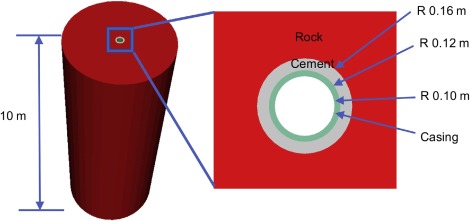International Journal of Greenhouse Gas Control ( IF 4.6 ) Pub Date : 2018-07-31 , DOI: 10.1016/j.ijggc.2018.07.012 Pratanu Roy , Joseph P. Morris , Stuart D.C. Walsh , Jaisree Iyer , Susan Carroll

|
Wellbore integrity is a critical component of long-term carbon storage. Depleted reservoirs that are potential CO2 storage sites, typically contain several wells. Due to years of operations and abandonment, these wells can have cracks in the cement, cement-casing interface, and/or cement-formation interface. During CO2 injection, changes in temperature may result in stress variations that can further damage the well, threatening its integrity. The temperature difference between the cold injected CO2 and warm reservoir, and different thermal properties for the wellbore casing, cement, and the lithology, will stress the near wellbore environment, potentially extending pre-existing defects creating leakage pathways from the storage reservoir to the overlying strata. We have conducted a systematic numerical study to explore the role of CO2 injection temperature, downhole effective in-situ horizontal stress, and the thermo-mechanical properties by coupling a linear elastic stress model with heat conduction. We consider conditions in non-perforated casing above the injection zone where conductive heating is dominant. The injection temperatures considered covers current industrial practice as well as sub-zero temperatures. The latter represents direct injection following ship transport, without pre-heating.
In this study, we consider the connection between damage risk and the temperature difference between the injected CO2 and the formation and downhole effective in-situ horizontal stress. The study found that the negative impacts of thermal stress in the wellbore environment are mitigated by the presence of effective in-situ horizontal stresses. Stresses normal to the well have the potential to reduce the tensile stress and stress intensity factor. In the absence of sufficient effective in-situ horizontal stress, thermal stress may cause the fracture to propagate due to high stress concentration near the fracture edges. In general, formations with large effective in-situ horizontal stress can prevent leakage paths from growing even when large temperature difference exists between the formation and the injected CO2. Our simulations suggest that CO2 can be injected at sub-zero temperatures, suitable for ship transport, when the downhole effective in-situ horizontal stress is greater than 10 or 12 MPa, depending on the location of the pre-existing cracks. For onshore transportation, injection of liquid CO2 results in minimal damage, provided there is ample in-situ horizontal stress.
中文翻译:

CO 2注入过程中热应力对井筒完整性的影响
井筒完整性是长期碳储存的关键组成部分。枯竭的油藏可能是潜在的CO 2储存地点,通常包含数口井。由于多年的运营和废弃,这些井在水泥,水泥套管界面和/或水泥地层界面中可能会出现裂缝。在注入CO 2的过程中,温度的变化可能会导致应力变化,从而进一步损坏孔,从而威胁其完整性。冷注入CO 2之间的温差井筒,水泥和岩性的不同热学性质以及热储层,将对附近的井筒环境造成压力,潜在地扩展先前存在的缺陷,从而形成从储层到上覆地层的渗漏通道。我们已经进行了系统的数值研究,以通过将线性弹性应力模型与热传导耦合来研究CO 2注入温度,井下有效原位水平应力以及热力学性质的作用。我们考虑注入区域上方非穿孔套管中的传导加热占主导的条件。所考虑的注射温度涵盖了当前的工业实践以及低于零的温度。后者表示船舶运输后的直接喷射,没有预热。
在这项研究中,我们考虑了损坏风险与注入的CO 2之间的温差之间的联系地层和井下有效的原位水平应力。研究发现,有效的原位水平应力可以减轻井眼环境中热应力的负面影响。垂直于井的应力可能会降低拉伸应力和应力强度因子。在没有足够有效的原位水平应力的情况下,由于裂缝边缘附近的高应力集中,热应力可能会导致裂缝扩展。通常,即使在地层与注入的CO 2之间存在较大的温差时,有效的原位水平应力大的地层也可以防止泄漏路径的增长。我们的模拟表明,CO 2当井下有效原地水平应力大于10或12 MPa时,可根据预先存在的裂缝的位置,在低于零的温度下注入,适用于船舶运输。对于陆上运输,只要有足够的原位水平应力,注入液态CO 2所造成的损害就很小。







































 京公网安备 11010802027423号
京公网安备 11010802027423号